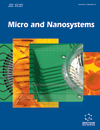-
oa Editorial [Hot Topic: Bio-Inspired Micro and Nanosystems (Guest Editor: Dusan Losic)]
- Source: Micro and Nanosystems, Volume 3, Issue 4, Dec 2011, p. 270 - 270
-
- 01 Dec 2011
Abstract
Nature through evolution of life over billion years has evolved biological systems and materials with high performance and unique properties from the macro to the nanoscale. These materials created by unique biologically mediated self-assembled processes and adaptability optimized through evolution have many remarkable properties including sophistication, multifunction, hierarchical organizations, hybridisation. Biologically inspired design of materials, processes and systems refereed as “biomimetics” is at the frontier between biological and material sciences, chemistry, physics, engineering and biotechnology and represent one of the most promising scientific and technological challenges in this century. Elucidating these properties, their building principles and functions is emerging multidisciplinary research field with perspective to build a bridge between biology and technology and solve today's most critical problems such as energy, health and sustained environment. The potential of these materials has inspired scientists and engineers to synthetise numerous new materials and devices using a biomimetic or bio-inspired approach. Successful examples include cat eye reflectors, gecko-like fasteners, self-cleaning lotus leaf-like surfaces, low-weight wood-like composite materials, butterfly-like antireflective coatings and opal effect pigments, self-repair plastics, bionic medical implants, and tissue repair. In this context the focus of this special issue on Bio-inspired Micro and Nanosystem is to show some recent advances on several specific aspects based on the physical, chemical, biological and biotechnological approaches. The issue is composed of selected contributions from recognised experts in this field presenting some of the most outstanding examples of nature's creations used for inspirational design of new materials and devices. Bioinspiration is a highly promising method in the design of emerging MEMS/NEMS with enhanced tribological properties and the paper by Ille C. Gebeshuber et al. introduces a new way to analyse best practice biological materials, structures and processes that were established via the biomimicry innovation method, by relating them to four main areas relevant for MEMS and related microsystems development: dynamic, mechanic, surface and structure related functions. Diatoms, single-cell photosynthetic algae (Bacillariophyta), are one of the most outstanding examples of 3-d micro to nano structured materials generated in nature showing unique optical, photonic, mechanical and sorting properties. A new multidisciplinary research field called diatom nanotechnology has recently emerged and review by M. D. Kurkuri et al. highlights some of recent applications based on the integration of micro and nanostructures including sensing/biosensing, drug delivery and chemical-free pest control.....


